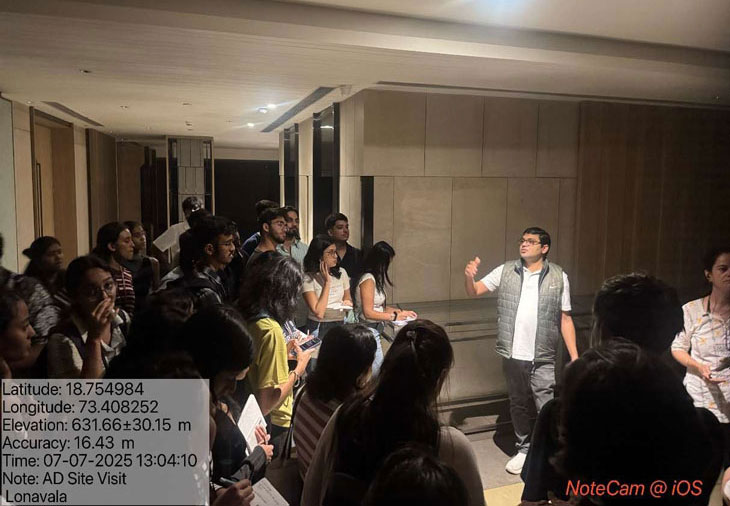| Subject | Architectural Design |
| Session | 2025-26 |
| Year | 2025 |
| Date | 7th July, 2025 |
| Time | 9:00 a.m. |
| Venue | Re genta Hotel, Lonavala Villa San Lawren, Lonavala |
| Faculty Co-ordinator | Prof. Ajita Deodhar |
| Guest Speaker | Ar. Rajesh Chauhan (Architect of Villa San Lawren) |
Purpose of Visit: The purpose of this visit was to familiarize students with the functional and service-oriented aspects of hospitality design through real-life examples. It aimed to strengthen their ability to integrate technical services with spatial planning in a 3-star hotel project.
Introduction: As part of the 3rd Year, 5th Semester Architectural Design curriculum, students are required to undertake a design project involving a 3-star hotel with a commercial interface. To strengthen their practical understanding, a case study visit was organized to two hotel projects in Lonavala — Villa San Lawren and Regenta Hotel. This visit aimed to provide students with hands-on exposure to the planning, services, and operational aspects of hospitality architecture.
The objective of this visit was to provide students with first-hand exposure to real-world hotel planning, service integration, and operational workflows. Guided by experienced architects and interacting with hotel staff from various departments, the students explored a wide range of aspects including site planning, spatial layouts, kitchen and back-of-house services, plumbing and electrical provisions, waste management systems, and guest amenities. This experience served as a vital bridge between theoretical classroom knowledge and its practical application in professional architectural practice.
Course Objectives:
- To expose students to real-life examples of hospitality architecture.
- To understand the integration of services and functional planning in hotel design.
- To study site-level planning and service distribution in large-scale projects.
- To enhance analytical skills by observing and documenting operational workflows.
- To relate theoretical design concepts with practical implementation.
Details of The Visit: The visit commenced with a tour of Villa San Lawren Resort, accompanied by its architect, Ar. Rajesh Chauhan. He explained various aspects of resort design, including service planning, kitchen layouts, toilet duct arrangements, and site-level services. Students explored the different service facilities and observed how functional requirements were integrated into the overall planning.
Following this, the team proceeded to Regenta Hotel, designed by Ar. Hosema Chitalwala. Here, students had the opportunity to interact with professionals from multiple departments to understand the working of different facilities such as kitchens, electrical systems, water treatment, solid waste disposal, hotel room layouts, and conference halls.
For a comprehensive study, students were divided into groups, each focusing on specific service aspects. This division enabled them to gather detailed data and insights, enhancing their understanding of hospitality architecture and its complex service integration.
Significance of The Visit: The case study provided students with first-hand exposure to the operational and spatial requirements of hotels, complementing their theoretical learning. It emphasized the integration of design with services and functional needs in hospitality projects.
Key Learnings and Conclusion: Through these visits, students acquired detailed knowledge of hospitality design, including the importance of planning for both visible guest areas and behind-the-scenes service spaces. The interaction with architects and hotel staff deepened their understanding of how different systems—such as electrical, plumbing, and waste management—are integrated seamlessly into the architectural design.
In conclusion, the case study visits successfully bridged the gap between academic learning and practical application, equipping students with valuable insights to implement in their own 3-star hotel design projects.







